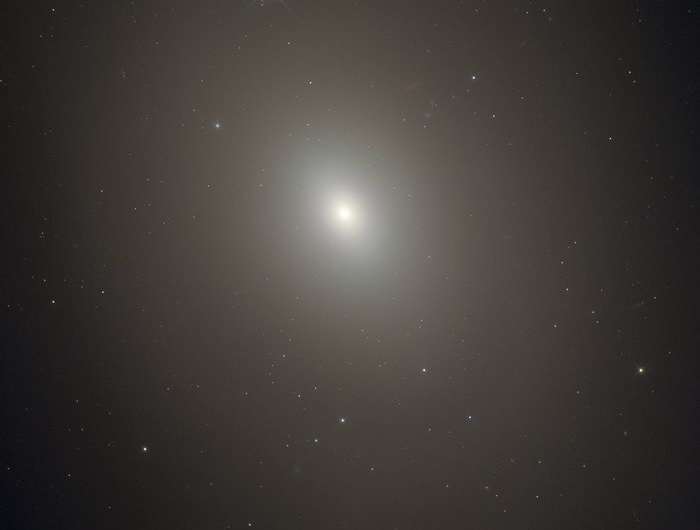January 13, 2022 report
Messier 85's complex globular cluster system explored by researchers

Using the Gemini North telescope, astronomers have conducted photometric and spectroscopic observations of a galaxy known as Messier 85. The observational campaign revealed more details about its complex globular cluster system. The findings are reported in a paper published January 5 on arXiv.org.
Globular clusters (GCs) are collections of tightly bound stars orbiting galaxies. Astronomers perceive them as natural laboratories enabling studies on the evolution of stars and galaxies. In particular, globular clusters could help researchers to better understand the formation history and evolution of early-type galaxies, as the origin of GCs seems to be closely linked to periods of intense star formation.
Located some 60 million light-years away from the Earth, Messier 85 (or M85, also known as NGC 4382) has a complex outer structure with shells and ripples, thought to be a result of a merger with another galaxy. It is estimated that this merger took place between 4 and 7 billion years ago.
Previous studies of M85 have revealed that it hosts a complex globular cluster system. Nearly 100 GCs have been identified in this galaxy, and astronomers divided them into three groups according to their colors—blue (BGC), green (GGC) and red (RGC). While all the subpopulations were found to be around 10 billion years old, it turned out that they showcase notable differences in their spatial distribution, kinematics and mean metallicities.
A team of astronomers led by Carlos G. Escudero of Institute of Astrophysics La Plata in Argentina studied the complex GC system of M85. For this purpose, they employed the Gemini Multi-Object Spectrograph (GMOS) camera on the Gemini North telescope to perform photometric and spectroscopic observations of the inner region of M85.
The study identified four GC groups in M85: typical blue (group A), red (group C), a group with intermediate colors to the previous ones (group B), and group with redder colors (group D). The astronomers managed to determine the radial velocity of 53 objects, confirming 47 GCs associated with M85.
According to the paper, the group A subpopulation has a mean radial velocity of 666 km/s with a radial velocity dispersion of 217 km/s. The mean age of GCs in this group is estimated to be 10.4 billion years, while the mean metallicity was measured to be -1.48. The group shows a negative metallicity gradient when moving away from the center of M85. This finding suggests that the origin of the blue GCs may be due to early dissipative events toward the inner regions of M85 with the subsequent accretion of GCs as a result of mergers with low mass galaxies.
The group B has a mean radial velocity of 751 km/s and radial velocity dispersion of 149 km/s. This group represents young GCs, with a mean age of just 2.2 billion years, and with mean metallicity at a level of -0.05. Within this group, the astronomers identified a hypercompact cluster, designated M85-HCC1, which is considered a tidally stripped galaxy center.
The subpopulation of red GCs (group C) turns out to have a mean radial velocity of 691 km/s, being closer to the value of the systemic velocity of the M85 galaxy, with a radial velocity dispersion of about 153 km/s. The mean age of these red GCs was estimated to be 12.1 billion years, and their mean metallicity was found to be approximately -0.64.
The researchers noted that it was not possible to spectroscopically confirm the photometric group D, which, according to them, would be composed of the so-called diffuse star clusters. However, the astronomers estimate that the mean metallicity for the GCs in this group is -0.54.
Given that towards the central region, M85 presents a luminosity-weighted mean age of about 2.7 billion years, and a metallicity increasing from −0.1 to 0.2 in this region, the authors of the paper underlined that these values are in good agreement with those obtained for the young GC population (group B). This suggests a common origin, as a consequence of a recent merger that M85 experienced.
"Combining all these findings, we can imagine a formation scenario for this galaxy where old metal-poor blue GCs are associated with the galaxy halo, old metal-rich red GCs were formed through the merger of clumps at high redshifts and the young GCs have originated in a recent encounters with neighboring galaxies, as well as the inner stellar population," the scientists concluded.
More information: Carlos G. Escudero et al, The complex globular cluster system of the S0 galaxy NGC 4382 in the outskirts of the Virgo Cluster. arXiv:2201.01759v1 [astro-ph.GA], arxiv.org/abs/2201.01759
© 2022 Science X Network




















